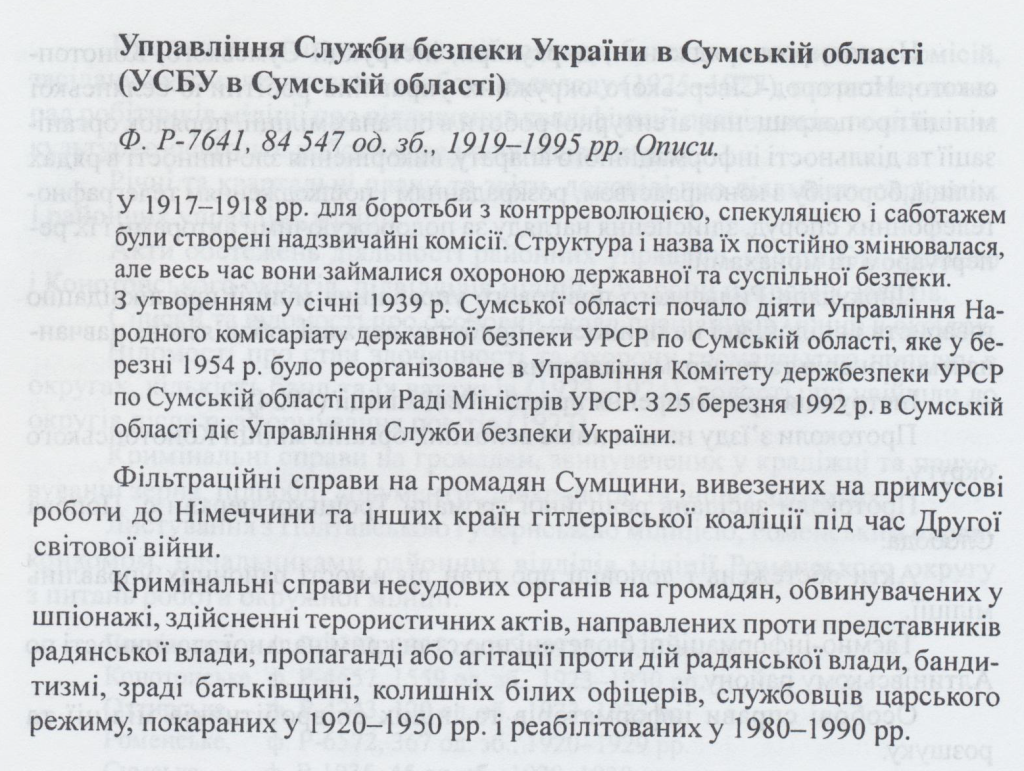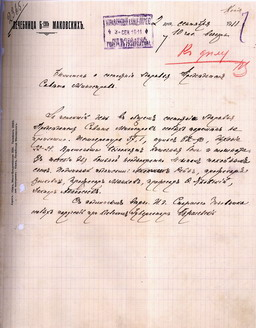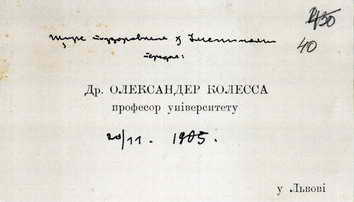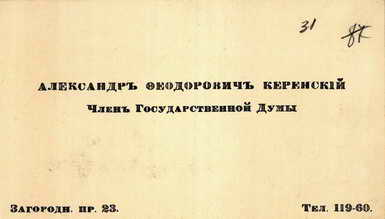
Ukrainian central and local archives are indispensable sources of information for any researcher interested in topics related to the past of Ukraine and its neighbors. They contain documents covering nine centuries of the country’s history (the oldest documents are dated by the late XII century). The total length of archival shelves in Ukraine is about one thousand kilometers. There are nine central archives and twenty-five regional (oblast) archives in today’s Ukraine. In addition to that, there are public libraries, museums, and research institutions that have valuable collections of unique historical documents. During the Soviet period, Ukrainian archives were tightly controlled and access to them was strictly regulated and limited. After the collapse of the Soviet Union in 1991, the policy of improving access to the previously classified archival holdings eventually led to a situation that exists in Ukraine today – almost 98% of archival records are declassified and available for researchers.
Working with Ukrainian archival records can be very rewarding and challenging at the same time. Researchers have to be aware that before 1991 the Ukrainian territory was part of other states during different historical periods and continued to be a contested territory during various military conflicts in modern history, including the two world wars. Therefore, valuable historical records pertaining to the Ukrainian past can be found in various archival institutions outside Ukraine: in Russia, Poland, Austria, Romania, Turkey, etc. On the other hand, many historical records related to Ukraine’s neighbors are part of Ukrainian archival collections.
Here is an example: Imagine that you are working on a topic related to social and cultural developments in Southern Ukraine including Crimea in the early 19th century. Your major archive would be the Odessa State Archive plus regional archives in Mykolaiv, Kherson, Dnipropetrovs’k, Zaporizhzhia oblasts, and Crimea. You would also have to do some research in the Academic Library of I.I. Mechnikov Odessa National University, for it contains a rich collection of periodicals and publications related to the period. In addition to that, you would have to address some Russian archival collections in Saint Petersburg and Moscow, and the reason for that is that the territory in question was a recent imperial acquisition, and its economic, political, and social development was to a significant degree controlled and influenced by the central imperial institutions of power and administration. To further illustrate this complexity, since 2014, the archives of the Republic of Crimea have been managed by the Russian Federation.
However, before going to any archive in Ukraine you would need to examine thoroughly (!) archival guides (putivnyky – in Ukrainian, or putevoditeli – in Russian). Newly published guides of all Ukrainian central and local archives (many of them available online in PDF format) provide detailed information on archival holdings and can be indispensable in helping to identify the most important and relevant documents. You may also want to contact the archive of your interest in advance informing the archival administration about the subject of your research and asking about the information and documentation that you will be required to provide in order to get access to the archive. Moreover, many archives now provide copying services that can be ordered remotely based on publically available detailed descriptions of holdings.
Depending on the topic of research, working knowledge of different languages may be required. Archival guides are published in Ukrainian. The archival terminology in Ukraine is slightly different from what is generally accepted and agreed upon in the United States. Here are some examples:
Fond [фонд] – integral group of records from one source (institution or individual) what we consider a record group or archive group. Each fond has its name and number. Opys [опис] – is an analog of a record or subgroup. The term itself means “description”, and it describes or lists the files in the fond, and therefore is of great informational value. It is usually marked with a number and title. Sprava [справа] – can be interpreted as a file. It is often called “odynytsia zberihannia” [одиниця зберігання] (unit of preservation). These are accrual files (folders or boxes). Arkush [sheet of paper] – this term is relevant to files containing actual sheets of paper, always numbered. In English we may use the word “page” in referential information.
Below is a copy of a page from the Putivnyk of Sumy Oblast State Archive. It provides the name and the number of the record group; the number of files (in this case they are referred to as “odynytsi zberihannia” – units of preservation); the time period which the record group covers; and a brief description of the record group.

Here are some examples of a standard archival reference in Ukrainian:

1. Центральний державний історичний архів України, м. Київ. Бюлетень про стан здоров’я П. А. Столипіна – 1911 р., вересня 2. (ЦДІАК, ф. 442, оп. 861, спр. 51, арк. 7) 1911 р., вересня 2. Bulletin on the health condition of P. A. Stolypin – 1911, September 2. (TsDIAK, f. 442, op. 861, spr. 51, ark. 7), 1911, September 2.

2. Візитки, вручені М. С. Грушевському (ЦДІАК, ф. 1235, оп. 1, спр. 875.) (ЦДІАК України) Business cards given to M.S Hrushevskyi (TsDIAK, f. 1235, op. 1, spr. 875)

Among English-language publications, the most important one is Patricia Kennedy Grimsted’s Archives and Manuscript Repositories in the USSR: Ukraine and Moldavia. Book 1. General Bibliography and Institutional Directory (Princeton University Press, 1988). Grimsted’s guide among other valuable features provides a thorough instruction on archival organization, arrangement and description, and access. One of the most important characteristics of the guide is its subject index, which is very helpful in identifying collections relevant to a researcher’s interests. However, the information on archival access is outdated due to the drastic changes in archival practices during the last two decades particularly due to the declassification of most archival holdings in all central and local archives.
Archival bibliography is another point of destination before going to an archive. Bibliographies can serve as detailed guides on a certain subject, individual archive, or a particular collection. All central and regional archives in Ukraine have their web pages. All central archives have English-language webpages that are helpful in obtaining useful information on archival collections, rules, hours of operations, regulations regarding patrons’ requests etc. Besides, web pages contain useful bibliographic information including lists of books and articles on special collections, published archival documents, and most recent archival research.
Additional publications and guides of Ukrainian archives that are held by the Library of the University of Illinois are listed on a separate page.
State Archival Service of Ukraine
The web portal of the State Archival Service of Ukraine provides a wide variety of information on Ukrainian archives, their organization, structure, services, publications, archival news, etc. The information on the portal is regularly updated. The English version of the old version of the website contains details on many Central and Regional archives in Ukraine that have not been transferred into the new website yet.